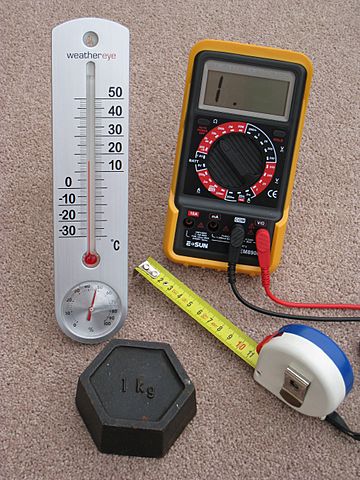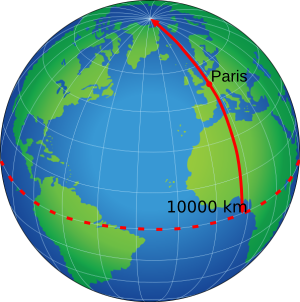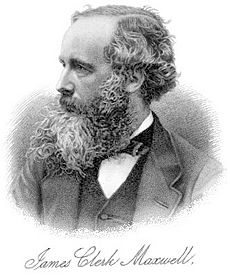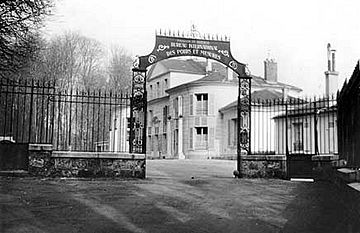Metric system facts for kids
The metric system is a way of measuring things that started in France in the 1790s. It uses a decimal system, meaning everything is based on groups of ten. Over time, this system grew into what we now call the International System of Units (SI). Almost every country in the world uses the metric system today! When a country switches to the metric system, it's called metrication.
The metric system is designed to be simple and universal. It picks a few basic measurements, like length or time, and calls them "base units." Then, it creates other units, called "derived units," from these base ones. For example, the unit for area (like the size of a floor) comes from the unit for length. All these units are connected by factors of ten, making it easy to convert between them.

Contents
How the Metric System Started
The metric system began during the French Revolution (1789–1799). Before that, France had many different ways to measure things, which made trade and daily life confusing. A man named Charles Maurice de Talleyrand suggested creating a new system based on natural measurements. He hoped this new system would be used worldwide.
In 1791, the French Academy of Sciences decided to create this new system. They chose to base the unit of length on the size of the Earth. They defined the 'metre' as one ten-millionth of the distance from the equator to the North Pole. In 1799, after careful measurements, the new metric system was officially launched in France.
The metric system was designed to be easy to use and widely accepted. Its units are based on the natural world, use decimal numbers, and have special prefixes for larger or smaller amounts.
How Metric Units Work
The metric system has a few key ideas that make it work well.
Base Units: The Building Blocks
The metric system uses seven main "base units" to measure different things. Think of these as the basic building blocks:
- Metre for length (how long something is).
- Kilogram for mass (how much "stuff" is in something).
- Second for time (how long something takes).
- Ampere for electric current (how much electricity flows).
- Kelvin for temperature (how hot or cold something is).
- Candela for luminous intensity (how bright a light is).
- Mole for amount of substance (how many tiny particles are in something).
These base units are now defined using exact values from nature, like the speed of light. This makes them very precise and universal.
Derived Units: Built from Base Units
"Derived units" are created by combining the base units. For example:
- Speed is measured in metres per second (m/s), combining length (metre) and time (second).
- Density (how much mass is in a certain space) is measured in kilograms per cubic metre (kg/m³).
Some derived units even have their own special names, like the watt for power or the joule for energy.
Decimal Ratios: Easy to Convert
One of the best things about the metric system is that it uses multiples of 10. This means converting between units is super easy!
For example, 1 kilometre is 1000 metres, and 1 centimetre is 0.01 metres. You just move the decimal point! This is different from older systems where you might have 12 inches in a foot, but 5,280 feet in a mile.
Prefixes: Making Numbers Simple

The metric system uses special prefixes to show multiples or fractions of a unit. These prefixes are the same for all units, which makes them easy to learn.
Here are some common prefixes:
- kilo- means 1,000 times (e.g., 1 kilometre = 1,000 metres).
- centi- means 1/100th (e.g., 1 centimetre = 0.01 metres).
- milli- means 1/1,000th (e.g., 1 millimetre = 0.001 metres).
So, a kilogram is 1,000 grams, and a milligram is one-thousandth of a gram.
When you use prefixes with units of area (squared) or volume (cubed), the prefix is also squared or cubed:
- 1 mm² (square millimetre) = (1 mm)² = (0.001 m)² = 0.000001 m²
- 1 km² (square kilometre) = (1 km)² = (1000 m)² = 1,000,000 m²
- 1 mm³ (cubic millimetre) = (1 mm)³ = (0.001 m)³ = 0.000000001 m³
- 1 km³ (cubic kilometre) = (1 km)³ = (1000 m)³ = 1,000,000,000 m³
Coherence: Units That Work Together

The metric system is "coherent." This means that the derived units are directly related to the base units without needing extra conversion factors. For example, if you use the metric units for mass and acceleration, the unit for force (the newton) will naturally fit the equation:
- force = mass × acceleration
This makes scientific equations much simpler because you don't need to add extra numbers to make the units match up.
Common Ideas in the Metric System
Many metric units are based on things we can easily understand or imagine:
- A second is about the time it takes for a heavy object to fall 4.9 metres.
- The Earth's equator is about 40,000,000 metres (40,000 kilometres) long. This was used to define the metre!
- A metre is close to the length of a pendulum that swings back and forth in 2 seconds. Most dining tables are about 0.75 metres high.
- A kilogram is the mass of one litre of cold water. A small 1-euro coin weighs about 7.5 grams.
- A candela is roughly the brightness of a normal candle.
- A mole of a substance has a mass in grams that matches its molecular mass. For example, a mole of carbon weighs 12.0 grams.
- A temperature difference of one kelvin is the same as one degree Celsius. Human body temperature is about 37 °C or 310 K.
The International System of Units (SI)
The International System of Units (SI) is the modern version of the metric system. It was created in 1960 by a group called the General Conference on Weights and Measures (CGPM).
The SI system is based on the metre, kilogram, second, and ampere units. It also includes many other derived units for things like power (watt) and energy (joule). The kelvin and candela were added later, and then the mole.
Today, the SI system has 7 base units and many derived units, including 22 with special names. Most base units are now defined using exact and unchanging constants from physics or mathematics. This means they are incredibly precise and don't rely on physical objects that could change over time. For example, the speed of light is now an exact number, and this number helps define the metre.
The SI system is always being updated. For example, in 2019, the kilogram's definition changed from a physical metal cylinder to a definition based on a fundamental constant of nature. Also, new prefixes have been added for extremely large or small numbers, like "quetta-" for 10³⁰ and "quecto-" for 10⁻³⁰.
See also
 In Spanish: Sistema métrico decimal para niños
In Spanish: Sistema métrico decimal para niños
- Binary prefix, used in computer science
- History of measurement
- List of metric units
- Metrology


